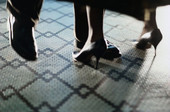
WEDNESDAY, Sept. 26 (HealthDay News) — Looking at gender-specific items — such as high heels for women or electric shavers for men — can influence how a person perceives the gender of someone with androgynous (neither specifically male or female) facial features, according to a new study.
German researchers had volunteers look at objects highly associated with one gender and then asked them to identify the gender of an androgynous face. Surprisingly, the participants were more likely to identify the face as being of the gender opposite to the gender associated with the item they saw.
The study was published Sept. 26 in the journal PLoS One.
Previous studies have shown that continuous exposure to visual stimuli leads to aftereffects caused by repeated stimulation of specific brain pathways. For example, people who look at a red screen for a long time are more likely to perceive a white screen as being green, which is the perceptual opposite of red.
There are two possible explanations for the finding of this new study, the researchers said.
Common brain regions may be involved in identifying gender-associated items and the gender of androgynous faces, so the effect seen in this study is similar to what occurs in the red screen/white screen experiment.
Or it may be that a higher brain function of “adapting to gender” may affect the process of “assigning gender,” whether to an object or face, the researchers suggested.
“This study highlights how exposure to objects in our environment can affect our perception of gender in everyday life,” lead author Amir Homayoun Javadi, of the Dresden University of Technology, said in a journal news release.
More information
The American Academy of Pediatrics has information on gender identity.

